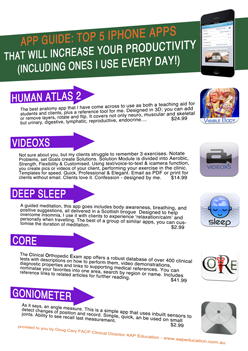Dry Needling Pre & Post Considerations
Following some recent questions about trigger point treatment and associated documentation, I have developed these themes for others interested in dry needling and acupuncture.

Technique to Desensitise Trigger Points
- After tapping needle into skin, initial needle depth penetration is achieved slowly (1-2 mm per second)
- Just before entering a specific trigger point, an increased tissue resistance can often be felt and pain is reported. As you 'drop' into the muscle, then sensation can diminish. It is interesting to note that an in vivo experiment by Kessler and Streitberger, 2008, found greater parathesia just before and just after impaling their own median nerve. Similar clinical finding - related? More detail is covered in the Advanced Upper Quadrant Course as we examine in detail the forearm flexor muscle group
- A visible/palpable twitch is commonly noted just at resistance and pain
- Following needle insertion, the goal is to use the minimum amount of stimulation to achieve a relaxation effect
Regardless of duration of complaint, the effect can be near immediate and long lasting, but this is variable.
A Suggested Grading System
This grading system was developed with two specific goals in mind.
- The first was to encourage accurate note taking. For example when a 'strong reactor' received acupuncture or dry needling, it would be noted, and in a multi-practitioner clinic, if this client was treated by another practitioner, they would know to use no extra stimulation
- The second was to encourage practitioners to consider the degree of stimulation that was required to achieve positive outcomes, without over stimulation a client's body and increasing the likelihood of adverse side effects
Grade 1 (Insert & Remove)
Use this if after the initial treatment (Grade 2), the client returns having had an excessive reaction.
Grade 2 (Up to 1 minute)
Insert needle and leave for up to 1 minute. Initially I wouldn’t stimulate a point at all. On removal of the needle, I then manually re-test the point. If not 50-75% reduced, reintroduce a needle, and proceed to Grade 3.
Grade 3 (Up to 3 minutes)
Use some gentle stimulation. e.g. fanning, twisting, flicking.
Grade 4 (Up to 10 minutes)
Use more gentle stimulation. e.g. fanning, twisting, flicking.
Grade 5 (Electro-acupuncture stimulation)
This technique is covered in the Advanced Lower Quadrant Course.
After Needle Insertion Care
- Slow removal, without direction change
- The application of digital pressure (no blood present) or cotton bud/alcohol swab (blood present) will minimise muscle bleeding. This is particularly important in the neck where small amounts of blood produce after pain. If a haematoma is formed, usage of local cooling will minimise bruising
- Often 1 minute after needle removal, the exquisite tenderness and spasm in the muscle has disappeared
- Application of heat is useful for post treatment pain
- If treating a particularly painful trigger point (upper trapezius), perhaps suggest an afternoon appointment so they are heading home and can manage post treatment soreness, rather than in the morning, when they will then need to be at work all day
Some Other Considerations
- During the initial treatment, it is better to under stimulate than over stimulate
- In conditions that have been present for greater than 3 months likewise minimise the stimulation
- 10% of the adult population and most children are ‘strong reactors’; meaning they only require transient insertion for pain relief
- The number of points treated, depends upon client comfort, past reactions and intensity of presenting trigger points
- Points should be palpated before and after treatment and objective signs reassessed to guide clinical direction
All the best,
Doug Cary FACP
Specialist Musculoskeletal Physiotherapist
email doug@aapeducation.com.au
ph/fx 08 90715055
Receive a FREE Information Report
Choose The Top 5 Manual Therapy Apps or Infection Control & Needling (V2)
Along with the report you'll also get a complimentary subscription to "Clinical Kit," our regular eZine (email newsletter) and Free Bronze Membership. You'll get ideas, information, insight and inspiration on a regular basis, plus access to our Resource Library, helping you unravel those clinical conundrums appearing every day.
You are free to use material from the Blog in whole or in part, as long as you include complete attribution, including live website link. Please also notify me where the material will appear. The attribution should read: "By Doug Cary FACP of AAP Education. Please visit our website at www.aapeducation.com.au for additional clinical articles and resources on post graduate education for health professionals" (Please make sure the link is live if placed in an eZine or in a web site.)
HOME | DRY NEEDLING | ANATOMY WET LAB |INTEGRATED NECK | 100% GUARANTEE | OUTCOME MEASURES | MSK & RTUS | BLOG

